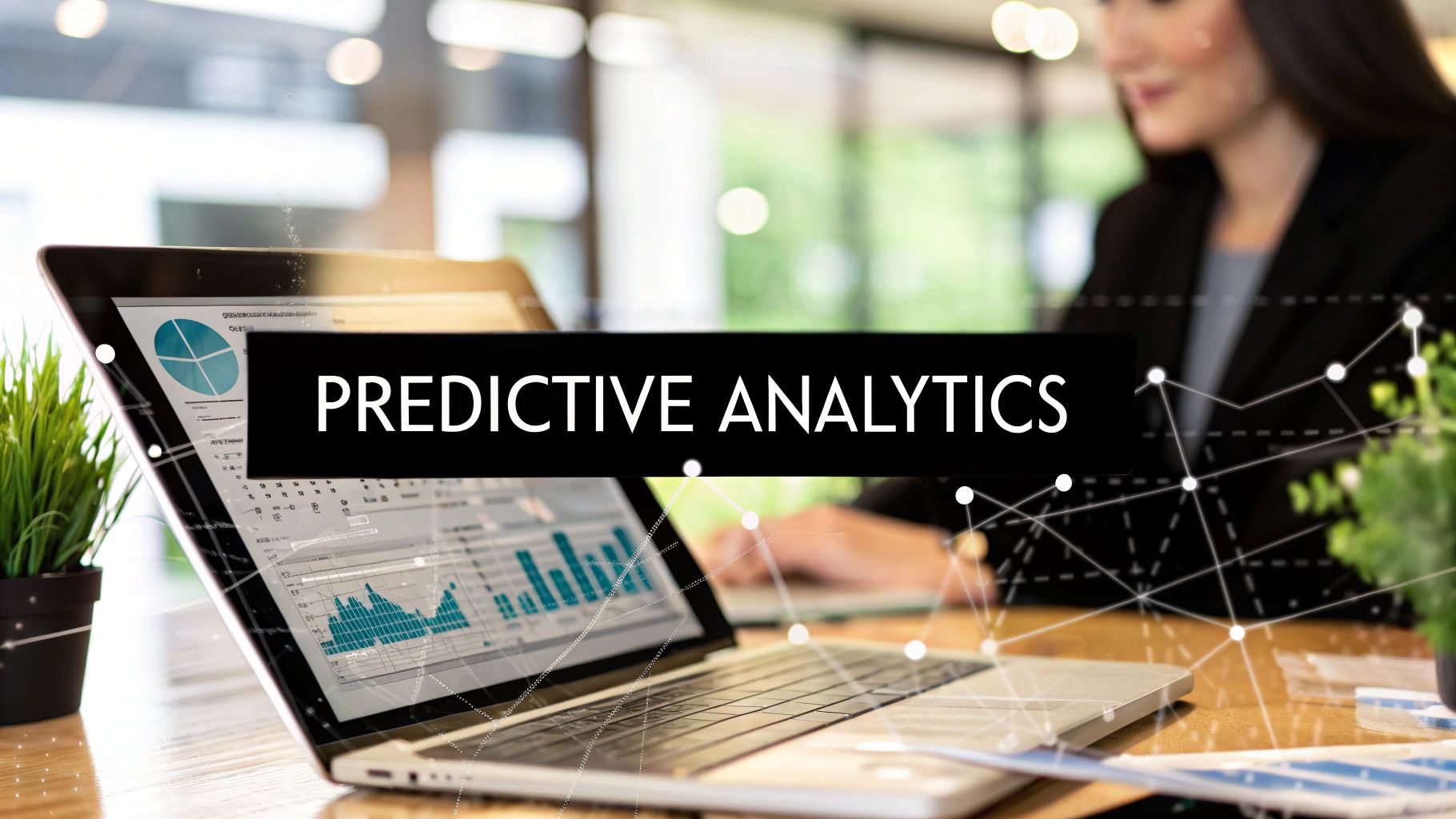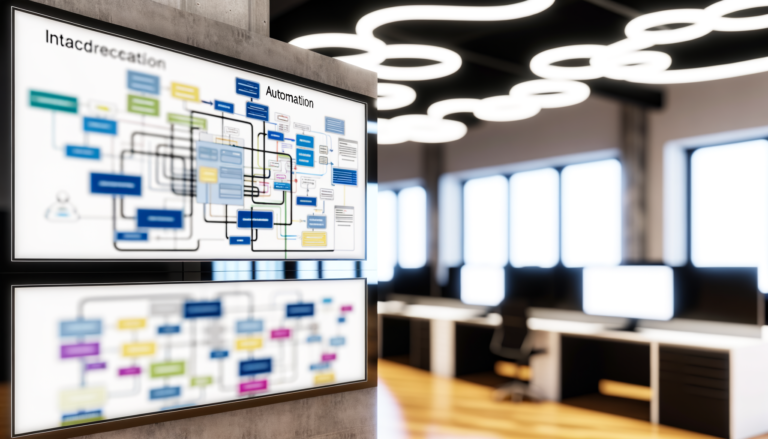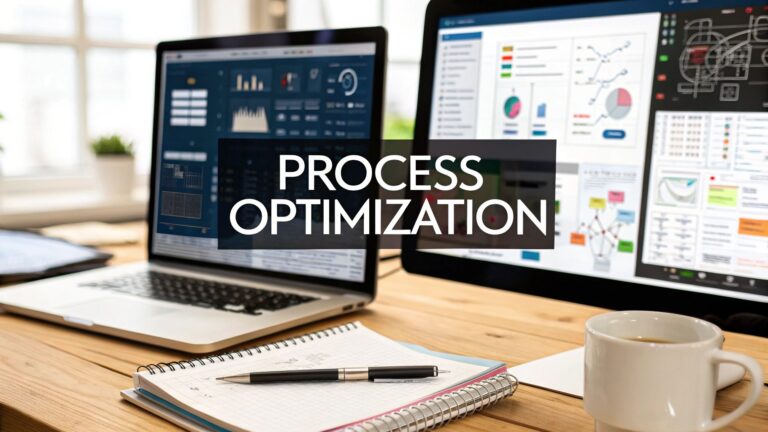What is Predictive Analytics? Unlock Future Business Insights
So, what exactly is predictive analytics?
Think of it less like a crystal ball and more like an incredibly sophisticated weather forecast for your business. It's the practice of digging into your past data, running it through some powerful statistical algorithms and machine learning models, and coming up with a highly educated guess about what's coming down the pike. It’s not about knowing the future with 100% certainty, but about making smarter bets on what’s likely to happen next.
This allows you to stop reacting to the market and start anticipating it.
Getting to the Heart of Predictive Analytics
At its core, predictive analytics is all about answering one critical question: "What's likely to happen?" It’s a huge leap from traditional business intelligence, which mostly looks in the rearview mirror to report on what has already occurred. This forward-looking approach is what makes it so powerful for any modern business.
To pull this off, predictive analytics brings together three key ingredients:
- Data: This is the raw material. We're talking about everything from historical sales numbers and customer information to website clicks and supply chain logs. The better the quality and relevance of your data, the sharper your predictions will be.
- Statistics: This is the logic engine. Statistical models are the workhorses that comb through your data, identifying hidden relationships and patterns between different variables that you’d never spot on your own.
- Machine Learning: This is the self-improving brain. As a core part of modern AI, machine learning algorithms don't just build a model and stop; they continuously learn from new data to refine their predictions and get more accurate over time. If you want to dive deeper into this, our guide on what AI means for your business is a great place to start.
Where Predictive Analytics Fits in the Big Picture
It's helpful to understand that predictive analytics isn't the only game in town; it's one of four distinct types of data analysis. Each one answers a different question, building on the insights of the one before it.
The growth in this space has been nothing short of explosive. The global predictive analytics market hit a value of roughly USD 17.87 billion in 2024 and is on track to reach USD 21.12 billion by 2025. Experts are forecasting a compound annual growth rate of over 22.7%, fueled by businesses everywhere realizing they need to make data-driven decisions to stay competitive.
This image really helps visualize how these core concepts come together.
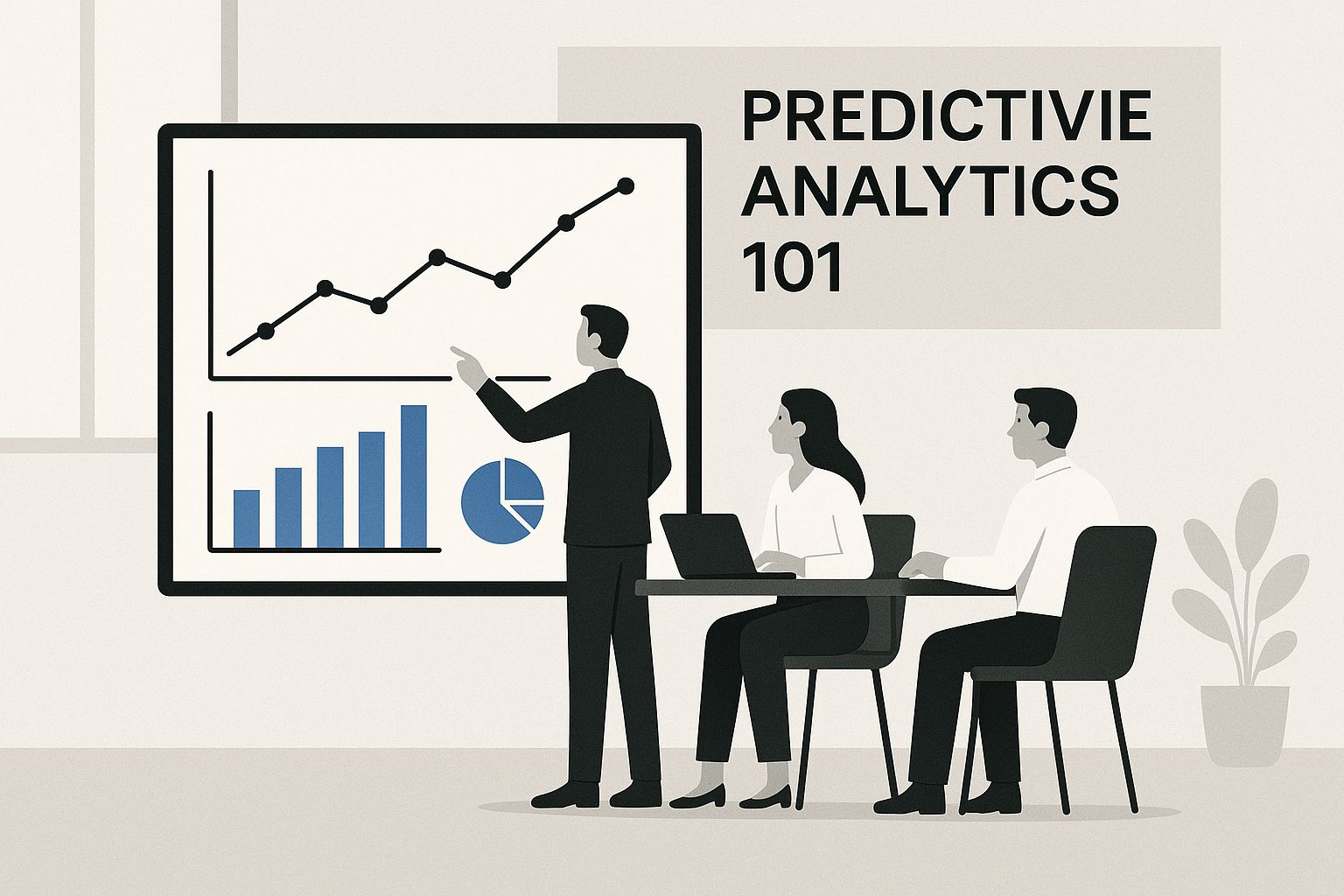
As you can see, it's a continuous cycle: data informs the model, the model generates predictions, and the outcomes help refine the entire process, leading to more actionable insights.
To really nail down where predictive analytics fits, let's compare it to its siblings. This table breaks down the four main types of data analytics, showing how each one plays a unique role.
The Four Types of Data Analytics Explained
| Type of Analytics | Key Question It Answers | Example |
|---|---|---|
| Descriptive | What happened? | A sales dashboard showing total revenue for last quarter. |
| Diagnostic | Why did it happen? | Digging into that sales data to find a marketing campaign caused a spike in a specific region. |
| Predictive | What is likely to happen next? | Forecasting next quarter’s sales based on historical trends and expected seasonal demand. |
| Prescriptive | What should we do about it? | Recommending the optimal inventory levels to meet the sales forecast without overstocking. |
As the table lays out, predictive analytics is that crucial link between understanding your past and actively shaping your future. It’s what turns your historical data from a simple record of events into a strategic roadmap for what lies ahead.
How Predictive Models Turn Data into Decisions

Predictive analytics might sound like something out of a sci-fi movie, but it's really about using specialized models to find meaningful patterns in the data you already have. These models are the workhorses that dig through your historical information and produce a forecast of what’s likely to happen next.
Think of them as a team of highly trained specialists. They don't guess; they calculate probabilities based on everything that has occurred in the past. Understanding how they work is the key to seeing how raw data gets translated into smart business moves.
Two of the most common and powerful types are classification and regression models. They tackle problems in different ways, but both aim to turn ambiguity into a clear advantage. Let's break down what they do.
The Expert Sorter: Classification Models
Imagine you have a huge pile of emails and need to sort them into "spam" and "not spam." A classification model does exactly that, but with your business data. Its entire job is to predict which category something belongs to.
It's answering a simple, direct question: "Which one is it?" or "Is it A or B?" The model learns the distinct features of each group from your past data and then applies that knowledge to new information, sorting it with lightning speed.
Here are a few real-world problems that classification models are built to solve:
- Customer Churn: Is this customer likely to cancel their service? (Yes/No)
- Fraud Detection: Does this credit card transaction look fraudulent? (Yes/No)
- Lead Scoring: Should we classify this new lead as hot, warm, or cold?
By slotting outcomes into clear categories, these models help you take specific actions. You can offer a deal to a customer at risk of leaving or put a temporary hold on a suspicious transaction for a human to review.
The Trend Spotter: Regression Models
While classification models put things in boxes, regression models are all about predicting a specific number. Think of it as looking at your sales figures for the past few years and drawing a trend line to estimate next quarter's revenue. A regression model does the same thing, only with much more sophistication.
It's the tool you turn to when you need to answer questions like "how much?" or "how many?" It uncovers the relationships between different variables—like how marketing spend impacts sales—and uses that logic to forecast a precise value.
Key Takeaway: Regression models are your go-to for forecasting quantities. They connect the dots between various factors to predict a single, continuous number, making them essential for financial planning, inventory management, and resource allocation.
For instance, a regression model can help you figure out:
- Sales Forecasting: What will our total revenue be next month?
- Demand Planning: How many units of product X will we need in our Texas warehouse this summer?
- Price Optimization: What’s the perfect price point to maximize our profit on a new service?
Beyond the Basics: Advanced Predictive Tools
Classification and regression are the foundational players, but the predictive analytics toolkit has more advanced options for trickier problems.
For example, decision trees create a visual, flowchart-like map of potential outcomes, making the model's logic easy for anyone to understand. On the other end of the spectrum, neural networks, which are modeled after the human brain, excel at finding subtle, complex patterns in enormous datasets. They power some of the most sophisticated tools out there, from image recognition to high-frequency trading algorithms. These advanced models help businesses tackle their most intricate challenges with a much greater degree of confidence.
Seeing Predictive Analytics in the Real World
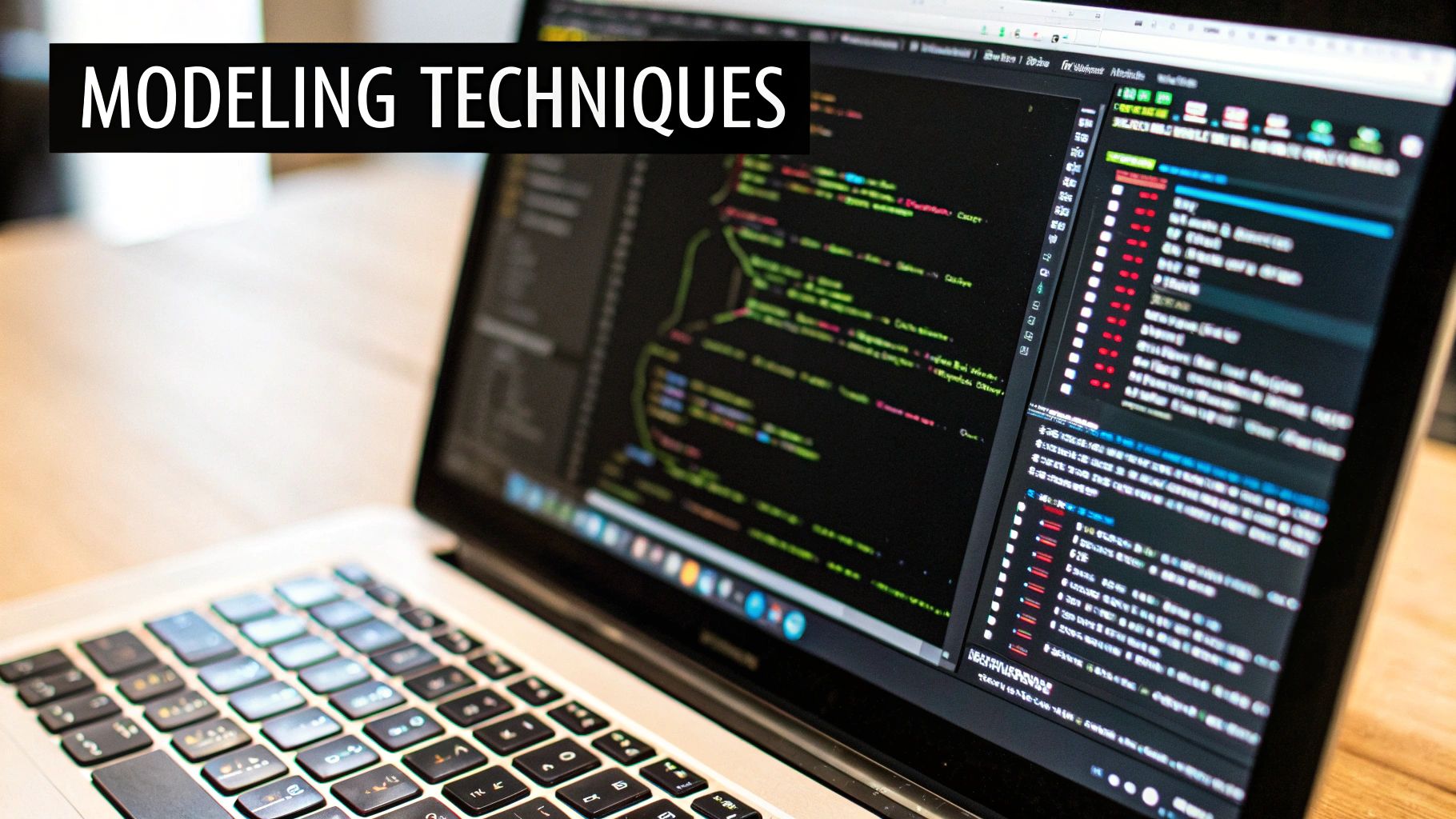
Understanding the models is one thing, but seeing predictive analytics in action is where it all clicks. This isn't just theory for a textbook; it's a practical tool that businesses use every single day to solve real problems and get a leg up on the competition.
Predictive analytics is quietly working behind the scenes all around us, from the product recommendations you see online to the fraud alerts you get from your bank. It's reshaping entire industries by turning past data into smart, forward-looking decisions that boost efficiency, grow revenue, and create better customer experiences.
Let's dive into a few examples from different sectors to see how this technology delivers real, measurable results.
Personalizing the Retail Experience
Ever wondered how an online store seems to know exactly what you’re looking for? That’s predictive analytics doing its thing.
E-commerce giants sift through mountains of data: your past purchases, browsing habits, the items you linger on, and even what other shoppers with similar tastes are buying. They feed all this information into a powerful recommendation engine that predicts what products you're most likely to buy next.
The impact on their bottom line is massive. By showing you products you actually want, they don't just increase the chance of a sale—they make your shopping experience better, which keeps you coming back.
This is especially powerful in marketing, where a good model can forecast which customer groups will respond best to specific ads, helping companies get the most out of their ad budget. You can dig deeper into predictive analytics in marketing to see just how it drives campaign success.
Protecting Your Finances from Fraud
The financial industry was an early adopter of predictive analytics for one crucial reason: fraud detection. Banks and credit card companies handle millions of transactions every day, making it impossible for a human team to watch over everything.
This is where predictive models shine. They're trained on historical transaction data to learn the unique spending DNA of each customer—your typical purchase locations, average spending amounts, and the kinds of stores you visit.
Key Insight: When a transaction pops up that looks completely out of character—say, a huge purchase in another country—the model flags it in real-time. This allows the bank to instantly block the card and shoot you a text, stopping theft before it even happens.
Improving Patient Outcomes in Healthcare
Healthcare is another area where predictive analytics is making a life-saving impact. Hospitals are sitting on a goldmine of patient data, from medical histories and lab results to lifestyle information. By analyzing this data, they can start to predict future health problems and step in before they become serious.
One of the most powerful applications is predicting hospital readmissions. Some patients have a much higher risk of ending up back in the hospital shortly after they're discharged, which is expensive for the system and terrible for the patient's health.
Here’s how predictive models help:
- Identify At-Risk Patients: Algorithms analyze factors like age, chronic conditions, and previous hospital stays to generate a "readmission risk score."
- Enable Proactive Care: Doctors and nurses can see these scores and identify high-risk individuals before they're even sent home.
- Deliver Targeted Support: This allows the care team to give these patients extra support, like follow-up calls or home health visits, dramatically lowering the chances they’ll need to be readmitted.
This move from reactive to proactive care is a game-changer, improving patient health while making hospitals run more smoothly. This kind of impact is why the global predictive analytics market, valued at USD 14.41 billion in 2024, is expected to skyrocket to USD 100.20 billion by 2034—growing at an annual rate of about 21.4%.
Building a Business Case for Predictive Analytics
Adopting predictive analytics isn't just a tech upgrade; it's a strategic move that hits your bottom line. Forget abstract concepts for a moment. The real value shines through when you connect this technology to tangible, measurable results. Predictive analytics isn’t a cost center—it's a powerful tool for driving efficiency, heading off risks, and finding new ways to grow.
By getting a clear view of future trends and behaviors, you can stop reacting to problems and start planning ahead. This shift means making smarter decisions that optimize your resources, keep customers happy, and give you a serious edge over the competition. Let’s dig into the specific, high-impact benefits that make a powerful business case.
Optimize Marketing and Sales Efforts
Guesswork in marketing is a costly habit. Predictive analytics replaces it with data-driven precision, making sure your marketing budget goes where it will actually make a difference. These models sift through customer data to figure out who is most likely to buy, what they’ll want, and when they’ll be ready.
This lets you build laser-focused campaigns that actually speak to specific customer segments. Instead of blasting everyone with the same generic message, you can tailor your offers and your words, which dramatically improves conversion rates and maximizes your marketing ROI.
A few game-changing applications include:
- Lead Scoring: Automatically flagging the leads most likely to become customers, so your sales team can stop chasing dead ends and focus their energy where it counts.
- Customer Segmentation: Grouping customers based on their predicted future behavior, not just what they've bought in the past.
- Personalized Recommendations: Forecasting the next product a customer will be interested in, which is a fantastic way to increase average order value and keep them engaged.
Slash Operational Costs
Inefficiencies are the silent profit killers in any operation. Predictive analytics puts a spotlight on these hidden costs by giving you accurate forecasts for crucial business functions, especially in your supply chain and resource planning.
Just imagine knowing, with a high degree of confidence, how much product you'll need in a certain warehouse three months from now. That single insight transforms inventory management from a frantic guessing game into a smooth, cost-effective process. By forecasting demand accurately, you avoid the dual pains of expensive overstocking and frustrating stockouts that send customers elsewhere.
Key Takeaway: Predictive analytics moves operational planning from "what happened last year" to "what's going to happen next." This shift directly cuts waste, improves how you use your resources, and trims unnecessary spending across the board.
Reduce Financial and Security Risks
Risk is an unavoidable part of doing business. Think of predictive analytics as your first line of defense, helping you spot and neutralize threats before they can do real damage. This is especially critical when it comes to financial fraud and cybersecurity.
For example, credit card companies use predictive models to watch millions of transactions as they happen. The models learn each customer's normal spending habits and can instantly flag anything that looks out of place—like a sudden purchase in a different country. This allows them to block fraudulent charges in seconds, saving everyone from a major headache and financial loss. The same logic applies to flagging potential loan defaults or even predicting when a critical piece of machinery is about to fail.
Boost Customer Loyalty and Retention
We all know it costs way more to find a new customer than to keep one you already have. Predictive analytics gives you the tools to truly understand why customers stick around and, more importantly, why they leave.
By analyzing things like engagement levels, support ticket history, and product usage, these models can generate a "churn risk" score for every customer. This score is your early warning system. It tells you which customers are drifting away or getting frustrated, giving you a chance to step in with targeted help, a special offer, or a personal phone call to win them back before they're gone for good. Understanding these numbers is fundamental, and you can learn more about how to measure business growth in our detailed guide.
Your Step-By-Step Implementation Framework
Jumping into predictive analytics isn't about flipping a switch and hoping for the best. It's a disciplined journey that demands a clear, strategic plan. By breaking it down into manageable steps, you can successfully move from a great idea to a working model that delivers real, measurable value.
Think of it like building a house. You wouldn't just start pouring a foundation without a detailed blueprint. This framework is your blueprint, guiding you from the initial spark of an idea all the way through to keeping your model sharp over the long haul.
Following a structured process helps you sidestep common traps, like building a technically brilliant model that solves the wrong problem or launching a solution your team has no idea how to use.
Step 1: Define Your Business Goal
Before a single line of code is written or a dataset is touched, you have to answer one critical question: What specific business problem are we trying to solve? This is, without a doubt, the most important step. A fuzzy goal like "we want to use AI" is a direct path to a failed project.
You have to get specific. Tie your objective to a tangible business outcome. Are you trying to cut customer churn by 15%? Boost your lead conversion rates by 25%? Or maybe slash fraudulent transactions by half?
Actionable Tip: A well-defined goal becomes your North Star for the entire project. It keeps everyone focused and gives you a clear benchmark for what success actually looks like when you're done.
Step 2: Gather and Prepare Your Data
Once you know your destination, it's time to gather the fuel for your predictive engine: data. Be warned, this is often the most time-consuming part of the whole process, but you absolutely cannot skimp on it. Your model's predictions will only ever be as good as the data it learns from.
This phase is all about getting your hands dirty. It involves a few key activities:
- Identifying Data Sources: This means pulling information from all the right places—your CRM, sales records, website analytics, and any other system that holds a piece of the puzzle.
- Cleaning the Data: This is the unglamorous but vital work of fixing errors, dealing with missing values, and getting rid of duplicate entries. It's the digital equivalent of washing your vegetables before you cook.
- Structuring the Data: Finally, you need to get all this information organized into a clean, consistent format that a machine learning algorithm can actually understand.
The explosion of predictive analytics is tied directly to the sheer volume of data we now have, thanks to everything from IoT devices to online platforms. As noted in research by Grand View Research, businesses are tapping into this data to create better customer experiences and run leaner operations. Paired with smarter AI, these models are becoming indispensable for making sharp, real-time decisions.
Step 3: Build and Train Your Model
Now for the fun part: actually building the model. This is where a data scientist or analyst steps in to choose the right type of algorithm—like a classification or regression model—that perfectly matches the goal you defined back in Step 1.
The model is then "trained" using your clean historical data. Think of it like a student studying for a test. It pores over the data, searching for hidden patterns and connections between different variables. For instance, it might learn that customers who haven't logged in for 30 days and have filed two support tickets are at an extremely high risk of leaving.
This isn't a one-shot deal. The training process is iterative, meaning the model is tested, tweaked, and retrained over and over again to make its predictions as accurate as possible before it's ready for the real world.
Step 4: Deploy the Model
A predictive model that just sits on a data scientist's laptop is completely useless. The entire point is to get its insights into the hands of people who can use them to make better decisions. This is what deployment is all about.
Deployment can look very different depending on the goal:
- It could mean embedding a lead score directly into your sales team's CRM.
- It might be the "recommended for you" section on your e-commerce website.
- Or it could be a dashboard that automatically flags high-risk accounts for your customer success team to proactively contact.
Step 5: Monitor and Refine
Here’s a secret: a predictive model is never truly "done." It’s not a set-it-and-forget-it tool. The world is constantly changing—customer behaviors evolve, markets shift, and new trends emerge. A model that was incredibly accurate six months ago could start to lose its edge over time.
This is why ongoing monitoring is non-negotiable. You need to constantly track your model's performance against what's actually happening in the real world. This allows you to retrain it with fresh data periodically, keeping its predictions sharp and relevant.
Keeping track of these procedures is critical, and our guide on business process documentation templates can give your team a solid framework to start with.
Navigating Common Challenges and Ethical Questions
Putting predictive analytics to work is a game-changer, but it's rarely a straight shot. The path is often bumpy, filled with practical hurdles and serious ethical questions that every organization needs to wrestle with. The key to building a program that’s not just effective but also responsible and sustainable is tackling these issues head-on from the start.
You have to be ready for the real-world speed bumps. Many predictive projects don't fail because the math is wrong; they fail because the groundwork isn't solid. These challenges are common, but ignoring them can bring your progress to a grinding halt.
Overcoming Practical Implementation Hurdles
The single biggest roadblock? Poor data quality. A predictive model is only as good as the data it’s fed. If your historical data is a mess—incomplete, full of errors, or locked away in separate systems—your predictions will be shaky at best. It's the classic "garbage in, garbage out" problem, and it's the absolute truth in data science.
Finding the right people is another huge challenge. Data scientists who can both master complex algorithms and truly understand your business don't grow on trees. Assembling a top-notch team means finding that rare mix of deep technical skill and genuine industry insight.
Finally, getting predictive insights woven into the fabric of daily operations is often tougher than it looks. This isn't just about adding a new dashboard; it’s about changing how people think and work. If your team isn't trained or isn't willing to trust what the models are telling them, even the most perfect predictions are worthless.
Confronting Critical Ethical Questions
Beyond the technical glitches, using predictive analytics opens up a Pandora's box of ethical questions that require serious consideration. How you navigate these can make or break your brand's reputation and the trust your customers have in you.
The most urgent issue by far is algorithmic bias. If the data you train a model on reflects historical prejudices against certain groups, the model will not only learn those biases—it will amplify them. This can lead to deeply unfair outcomes in hiring, loan approvals, or even healthcare.
A Question of Fairness: A model doesn't know what's fair. It just sees patterns. If society's biases are baked into your historical data, the algorithm will see that bias as a signal to follow, creating a vicious cycle of discrimination.
This brings us to the need for transparency. When a model makes a call that impacts someone's life, you have to be able to explain why. Opaque "black box" models, where the inner workings are a mystery, destroy trust and make it impossible to spot and fix hidden biases.
And then there's the tightrope walk between personalization and privacy. Predictive models are fantastic for creating bespoke customer experiences, but that requires a mountain of personal data. Businesses have to tread carefully, using that data to create real value without becoming intrusive or creepy. It all comes down to respecting user consent and making data security a top priority.
Got Questions? We've Got Answers
Even after diving into the world of predictive analytics, a few common questions tend to pop up. Let's tackle them head-on to clear up any lingering confusion.
What's the Real Difference Between Machine Learning and Predictive Analytics?
It's a classic mix-up, but the relationship is actually pretty straightforward. Think of it this way: predictive analytics is the destination, and machine learning is one of the high-tech vehicles you can use to get there.
Predictive analytics is the broader discipline of using data to forecast what's next. Machine learning (ML) is a powerful set of techniques within that discipline. While you can build simple predictive models with basic statistics, ML algorithms create sophisticated models that learn from data and get smarter over time, which is why they’re the engine behind today's most accurate predictions.
What Skills Does a Predictive Analyst Actually Need?
A truly effective predictive analyst is a rare breed—part data scientist, part business strategist. You can't just be good with numbers; you have to know what the numbers mean for the business.
- The Tech Side: You absolutely need a solid foundation in programming languages like Python or R, comfort with databases (especially SQL), and a real grasp of statistical modeling and machine learning concepts. This is the non-negotiable toolkit.
- The Business Side: The best analysts are problem-solvers first. They have sharp business acumen, meaning they understand their industry inside and out. They can translate complex data findings into plain English and, most importantly, show how their work directly helps the company achieve its goals.
How Can a Small Business Dip Its Toes in the Water?
You don't need a Fortune 500 budget to get started. Predictive analytics has become much more accessible, and small businesses can get going with tools they might already be using.
Your Best First Step: Check your existing software. Many modern CRM and marketing platforms now include built-in predictive features for things like lead scoring or customer churn risk. Toggling these on is a low-cost, low-risk way to see what predictive insights can do for you.
Once you see the value, you can start exploring more dedicated tools. This approach lets you grow into a more advanced strategy without a huge upfront investment.
Ready to stop reacting and start predicting? The team at MakeAutomation specializes in implementing AI and automation frameworks that give your business a forward-looking edge. We'll help you build scalable processes that drive growth and eliminate guesswork. Learn how we can optimize your operations today.

